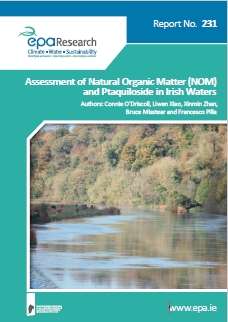Research 231: Assessment of Natural Organic Matter (NOM) and Ptaquiloside in Irish Waters
Authors: Connie O’Driscoll, Liwen Xiao, Xinmin Zhan, Bruce Misstear and Francesco Pilla
Summary: Ireland has an unacceptably high number of drinking water supplies that exceed the parametric value of 100 μg L-1 for total trihalomethanes (THMs) and has been reporting the highest non-compliance with respect to total THMs in drinking water across the 27 EU Member States.

Identifying pressures
This research identified high-risk catchments for public and private water supplies in relation to NOM across Ireland. This study highlighted that presence of peatland in the catchment is an important factor contributing to THMs in supplies where water has no pre-treatment and receives chlorine disinfection only. Furthermore, in supplies where there is removal, to some degree, of natural organic matter, presence of both peatland and pasture give rise to higher concentrations of THMs. The extent of bracken coverage in Ireland is not known. Ptaquiloside concentrations were detected in the bracken fronds from frond emergence to plant die-off and in the receiving drinking water supply on one sampling occasion at plant die-off.
Informing policy
The findings from this research suggest that there is a need for policy that recommends the use of a high-risk catchment map tool such as that trialled in this research in establishing monitoring programmes for collation of baseline data on NOM quantity and character for the design of new/upgraded WTPs. Audit monitoring of THMs to comply with the Drinking Water Regulations should consider the nature of the source water accounting for both the seasonal flush of NOM in the autumn period and episodic rainfall events where supplies are influenced by such events. Accurate mapping of zones of contribution should be a prerequisite for drinking water supplies. Consideration should be given to the localised predicted effects of climate change on NOM concentrations in water supplies and monitoring of high-resolution data. The extent of bracken coverage in Ireland should be
established using remote sensing with ground-truthing to accurately determine the extent of the bracken problem in Ireland. There is a need for policy that can increase the level of awareness of the possible risks of bracken and ptaquiloside to private drinking water wells.
Developing solutions
The establishment of a national water utility in 2014 represents a significant opportunity for improving THM compliance through systematic connectivity and viewing each abstraction source as a function of its catchment rather than of its management boundaries. The findings of the ptaquiloside study from this research suggest that there is a need for stakeholder awareness, with regard to ensuring bracken-free zones close to water abstraction sources, especially for supplies with short water residence times. Investigation into the ptaquiloside concentrations of bracken subjected to different management treatments indicated that spraying with asulam was the most effective means of control for reducing ptaquiloside load. Asulam, the most effective herbicide for eradicating bracken is currently banned in the EU and can only be used with derogation. This finding indicates that cutting
bracken may increase the production of ptaquiloside in the short term and hence the potential risk to drinking water quality. However, asulam is a pesticide and is itself potentially harmful to drinking water.
https://www.epa.ie/media/epa-2020/publications/research/Research_231_thumbnail[1].jpg